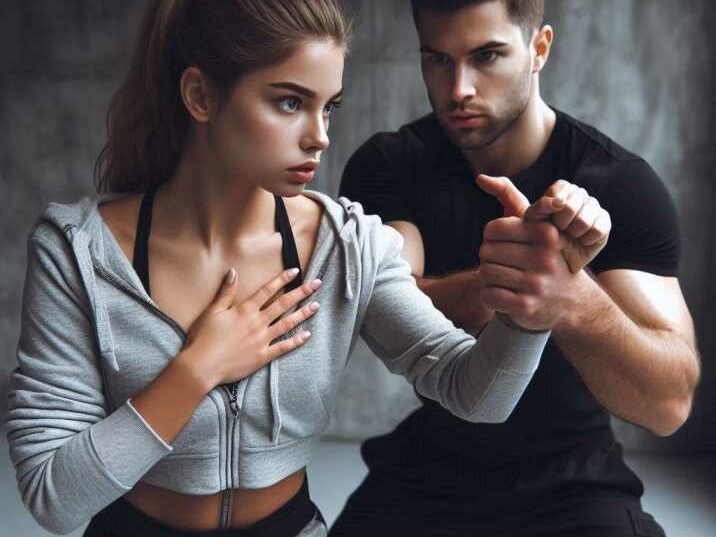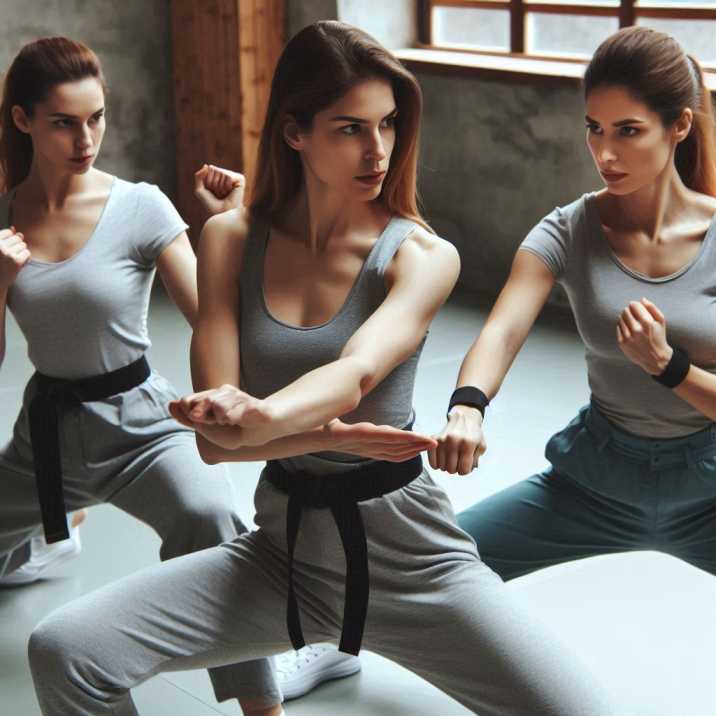Self-defence is an important skill for everyone, but it’s especially crucial for women who may find themselves in situations where they need to protect themselves. Martial arts offer a great way for women to learn self-defence techniques, boost confidence, and improve physical fitness. In this article, we’ll explore some of the best self-defense martial arts for women and how they can empower you to feel safer and more confident.

Why Women Should Learn Martial Arts
Table of Contents
Martial arts are not just about fighting; they’re about learning how to defend yourself, building strength, and improving your mental well-being. Here are some reasons why women should consider learning martial arts:
- Self-defense skills: Learn effective techniques to protect yourself in dangerous situations.
- Increased confidence: Knowing you can defend yourself can boost your confidence.
- Physical fitness: Martial arts improve strength, flexibility, and endurance.
- Stress relief: Practicing martial arts can help reduce stress and anxiety.
- Community: Joining a martial arts class offers a supportive environment to learn and grow.
Choosing the Right Self-Defense Martial Arts for Women
When choosing a martial art for self-defense, consider your personal goals, physical abilities, and preferences. Here are some popular martial arts for self-defense:
1. Brazilian Jiu-Jitsu (BJJ)
What is Brazilian Jiu-Jitsu?
Brazilian Jiu-Jitsu (BJJ) is a martial art and combat sport that focuses on ground fighting and grappling. It was developed in Brazil in the early 20th century, drawing from traditional Japanese jiu-jitsu and judo techniques. BJJ emphasizes the importance of technique, leverage, and timing to defeat larger and stronger opponents, making it particularly effective for self-defense.
Key Techniques in Brazilian Jiu-Jitsu
- Grappling and Holds: BJJ teaches you how to control and submit an opponent through various holds and grappling techniques.
- Submissions: Techniques like joint locks and chokeholds are used to incapacitate an opponent without the need for strikes.
- Escapes and Transitions: Learn how to escape from dangerous positions and transition to more advantageous ones.
Benefits for Women
Effective for Smaller Individuals
- Leverage Over Strength: BJJ relies heavily on technique and leverage, allowing smaller individuals to defend themselves against larger attackers.
- Energy Efficiency: The focus on leverage means less energy is expended, which is advantageous for someone facing a physically stronger opponent.
Realistic Self-Defense
- Ground Defense Skills: Many real-life confrontations end up on the ground, and BJJ equips practitioners with the skills to defend themselves effectively in these scenarios.
- Control and Submission: Instead of relying on striking, BJJ practitioners learn to control and submit their opponents, which can be more practical in close encounters.
Empowering Experience
- Confidence Building: As you progress in BJJ, you gain confidence in your ability to handle physical confrontations.
- Problem-Solving Skills: BJJ teaches you to think strategically and solve problems under pressure, which can be empowering both on and off the mat.
Why Women Choose Brazilian Jiu-Jitsu
Women often choose BJJ for its practicality in self-defense, the supportive community, and the sense of empowerment it provides. Classes are typically structured to include both technique drills and live sparring, offering a comprehensive learning experience.
2. Krav Maga
What is Krav Maga?
Krav Maga is a self-defense system that was developed for the Israeli military in the mid-20th century. It is known for its focus on real-world scenarios and its practicality in neutralizing threats quickly. Krav Maga incorporates techniques from various martial arts, including boxing, wrestling, judo, and karate.

Key Techniques in Krav Maga
- Striking Techniques: Krav Maga uses punches, kicks, elbows, and knee strikes to disable an attacker.
- Defensive Moves: Learn to defend against common attacks, including grabs, chokes, and weapon threats.
- Neutralizing Threats: Emphasis on quickly and effectively neutralizing threats using any means necessary.
Benefits for Women
Practical Self-Defense
- Realistic Scenarios: Krav Maga focuses on real-world situations, preparing practitioners for potential street confrontations.
- Simple and Effective: Techniques are designed to be simple and effective, ensuring quick and decisive action during an attack.
Fast Learning Curve
- Quick to Learn: Krav Maga is designed to be easily learned and applied, making it ideal for those with limited training time.
- Adaptability: Techniques can be adapted to fit various situations and physical capabilities.
Increased Awareness
- Situational Awareness: Training emphasizes recognizing and avoiding dangerous situations before they escalate.
- De-escalation Skills: Learn how to use verbal and physical techniques to de-escalate conflicts when possible.
Why Women Choose Krav Maga
Women choose Krav Maga for its effectiveness in self-defense, the rapid progression of skills, and the focus on real-world applicability. Classes often include scenario-based training, allowing practitioners to practice techniques in a controlled yet realistic environment.
3. Muay Thai
What is Muay Thai?
Muay Thai, often referred to as “The Art of Eight Limbs,” is a traditional martial art from Thailand that utilizes the entire body as a weapon. It incorporates punches, kicks, elbows, and knee strikes, making it a comprehensive striking art. Muay Thai is renowned for its effectiveness in both competitive fighting and self-defense scenarios.
Key Techniques in Muay Thai
- Striking Combinations: Techniques involve using all parts of the body to deliver powerful combinations.
- Clinch Fighting: Muay Thai includes clinch techniques, allowing you to control and strike an opponent at close range.
- Defensive Skills: Practitioners learn to block, dodge, and counter various attacks.
Benefits for Women
Powerful Strikes
- Effective Self-Defense: Learn to deliver strong and precise strikes to defend against attackers effectively.
- Confidence in Striking Ability: Training in Muay Thai builds confidence in your ability to protect yourself using powerful techniques.
Improved Fitness
- Cardiovascular Health: Muay Thai is an intense workout that significantly improves cardiovascular fitness and endurance.
- Muscle Tone and Strength: Regular practice helps tone muscles and increase overall strength, contributing to better health.
Confidence Building
- Mental Resilience: Training in Muay Thai fosters mental toughness and resilience, empowering you to face challenges both in and out of the ring.
- Stress Relief: The physical intensity of Muay Thai serves as a great outlet for stress and anxiety.
Why Women Choose Muay Thai
Women often choose Muay Thai for its dynamic and empowering approach to self-defense. It provides a full-body workout while teaching effective self-defense skills. The community aspect of training in Muay Thai gyms also offers a supportive and motivating environment.
4. Judo
What is Judo?
Judo is a Japanese martial art founded by Jigoro Kano in the late 19th century. It focuses on throws and takedowns, teaching practitioners how to use an opponent’s energy and momentum against them. Judo emphasizes efficiency and leverage, making it ideal for self-defense and sport.
Key Techniques in Judo
- Throws and Takedowns: Learn to execute throws that use leverage and balance to take opponents off their feet.
- Ground Control: Judo includes groundwork techniques such as pins and joint locks to control or submit an opponent.
- Balance and Movement: Emphasis on maintaining balance and using effective footwork to destabilise opponents.
Benefits for Women
Leverage-Based Techniques
- Ideal for Smaller Individuals: Judo relies on leverage rather than brute strength, making it accessible and effective for women of all sizes.
- Efficient Self-Defense: Learn to neutralize larger opponents using technique and timing.
Control and Restraint
- Non-violent Solutions: Judo teaches how to control an opponent without causing harm, focusing on restraint and de-escalation.
- Practical Applications: Techniques are applicable in various self-defense scenarios, emphasizing control over aggression.
Self-Discipline
- Focus and Concentration: Training in judo develops discipline, patience, and focus, qualities that benefit practitioners in all areas of life.
- Personal Growth: Judo encourages continuous improvement and self-reflection, fostering personal development.
Why Women Choose Judo
Women choose judo for its emphasis on technique, control, and efficiency. It offers a safe and supportive environment to learn practical self-defense skills while promoting personal growth and discipline.
5. Taekwondo
What is Taekwondo?
Taekwondo is a Korean martial art known for its dynamic and high-flying kicking techniques. It combines self-defense, sport, and fitness elements, making it a versatile martial art. Taekwondo is practiced worldwide and is recognized as an Olympic sport.
Key Techniques in Taekwondo
- Kicking Techniques: Taekwondo is famous for its powerful and precise kicks, including roundhouse, side, and spinning kicks.
- Striking Skills: In addition to kicks, Taekwondo practitioners learn punches, blocks, and defensive maneuvers.
- Forms (Poomsae): Practitioners learn forms, which are pre-arranged sequences of movements that develop technique and discipline.
Benefits for Women
Fast Kicks and Agility
- Speed and Precision: Taekwondo emphasizes speed and agility, teaching practitioners to deliver quick and accurate strikes.
- Effective Self-Defense: Learn to use dynamic kicks to defend against attackers and maintain distance.
Improved Flexibility
- Increased Range of Motion: Regular practice improves flexibility and balance, enhancing overall physical performance.
- Injury Prevention: Improved flexibility reduces the risk of injuries in both training and daily activities.
Mental Focus
- Concentration and Clarity: Taekwondo enhances mental focus, concentration, and clarity, contributing to better decision-making and problem-solving skills.
- Confidence Building: Achieving goals in Taekwondo, such as belt promotions, boosts self-esteem and confidence.
Why Women Choose Taekwondo
Women choose Taekwondo for its emphasis on agility, flexibility, and mental focus. It provides an excellent workout while teaching effective self-defence techniques. The structured curriculum and goal-oriented training approach make Taekwondo an appealing choice for women seeking personal development and empowerment.
Tips for Women Starting Martial Arts
Starting a martial art can be an exciting yet intimidating experience. Here are some helpful tips to ensure a positive and rewarding journey:
1. Research Schools and Instructors
- Find the Right Fit: Take the time to research different martial arts schools in your area. Look for schools that specialize in the martial art you’re interested in, and consider factors such as location, class schedules, and fees.
- Experienced Instructors: Choose a school with experienced instructors who are knowledgeable and certified in their discipline. A good instructor will not only teach techniques but also foster a positive learning environment.
- Safe and Supportive Environment: Visit schools to observe classes and assess the atmosphere. Look for a supportive and inclusive environment where you feel comfortable and respected. This is crucial for your growth and enjoyment in martial arts.
2. Set Realistic Goals
- Define Your Objectives: Before starting, think about what you hope to achieve through martial arts. Are you interested in self-defense, fitness, competition, or personal development?
- Achievable Milestones: Break down your goals into smaller, achievable milestones. This can include learning specific techniques, attending a certain number of classes per week, or progressing to the next belt level.
- Progress at Your Own Pace: Remember that everyone progresses at different rates. Focus on your own journey and avoid comparing yourself to others. Celebrate your accomplishments, no matter how small they may seem.
3. Stay Consistent
- Regular Practice: Consistency is key to improvement. Try to attend classes regularly and practice techniques outside of class to reinforce what you’ve learned.
- Create a Routine: Establish a training schedule that fits your lifestyle. Whether it’s attending classes a few times a week or practicing at home, consistency will help you build skills and confidence.
- Stay Committed: Martial arts is a long-term journey. Stay committed to your practice, even when progress seems slow or challenges arise.
4. Listen to Your Body
- Be Mindful: Pay attention to how your body feels during training. Martial arts can be physically demanding, so it’s important to recognize your limits.
- Prevent Injuries: Avoid pushing yourself too hard, especially when you’re starting out. Overtraining can lead to injuries, which can set back your progress and diminish your enthusiasm.
- Rest and Recover: Allow time for rest and recovery. This is essential for your body to heal and grow stronger. Incorporate stretching, hydration, and proper nutrition into your routine to support your training.
5. Build a Support Network
- Connect with Peers: Form connections with fellow students. A supportive network can provide motivation, encouragement, and camaraderie.
- Learn from Others: Don’t hesitate to ask for help or advice from more experienced students and instructors. Learning from others’ experiences can enrich your training.
- Share Your Journey: Participate in school events, workshops, and seminars. Sharing your journey with others can enhance your sense of community and deepen your engagement with martial arts.
Table of Information about Self-Defense Martial Arts for Women
| Martial Art | Key Focus | Ideal For | Benefits |
|---|---|---|---|
| Brazilian Jiu-Jitsu | Ground Grappling | Smaller individuals | Leverage-based techniques, realistic self-defense |
| Krav Maga | Practical Self-defense | Real-world situations | Fast learning curve, increased awareness |
| Muay Thai | Striking | Powerful strikes | Improved fitness, confidence building |
| Judo | Throws and Takedowns | Leverage-based control | Self-discipline, control and restraint |
| Taekwondo | Kicking Techniques | Agility and speed | Improved flexibility, mental focus |
Conclusion
Learning martial arts is a powerful way for women to develop self-defense skills, improve physical fitness, and gain confidence. Whether you choose Brazilian Jiu-Jitsu, Krav Maga, Muay Thai, Judo, or Taekwondo, each martial art offers unique benefits that can empower you to feel safer and more secure. Start your martial arts journey today and discover the strength and confidence you have within you.
FAQs
1. Which martial art is best for women’s self-defense?
Brazilian Jiu-Jitsu and Krav Maga are often recommended for women’s self-defense due to their focus on leverage and practical techniques.
2. How long does it take to learn self-defense?
The time it takes to learn self-defense varies, but consistent practice can lead to noticeable improvements within a few months.
3. Can martial arts improve confidence?
Yes, martial arts can significantly boost confidence by teaching you how to defend yourself and improving physical fitness.
4. Is martial arts training safe for women?
Martial arts training is generally safe when practiced under the guidance of qualified instructors in a supportive environment.
5. Do I need to be in shape to start martial arts?
No, you don’t need to be in shape to start martial arts. Many people begin training to improve their fitness levels and overall health.


